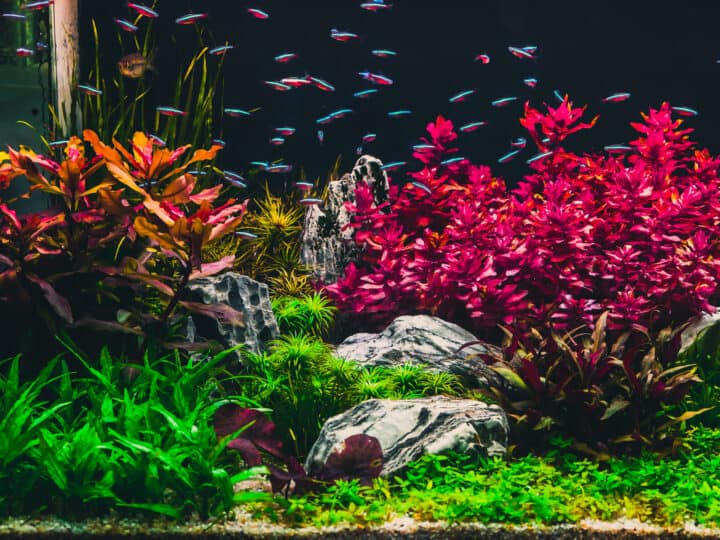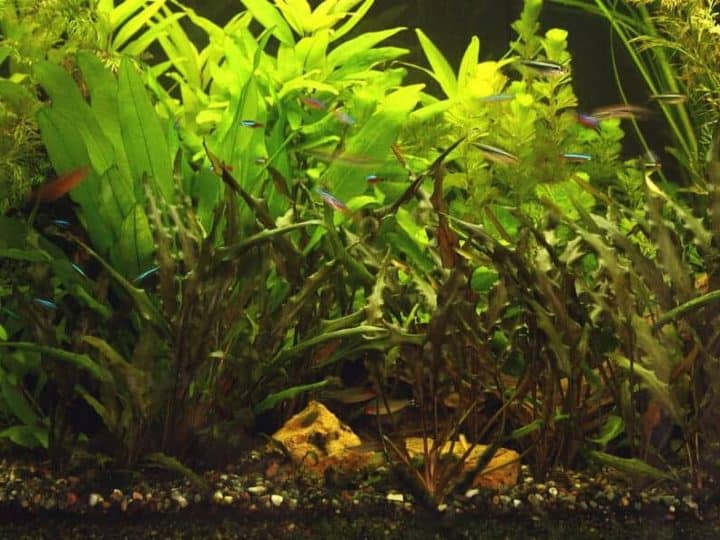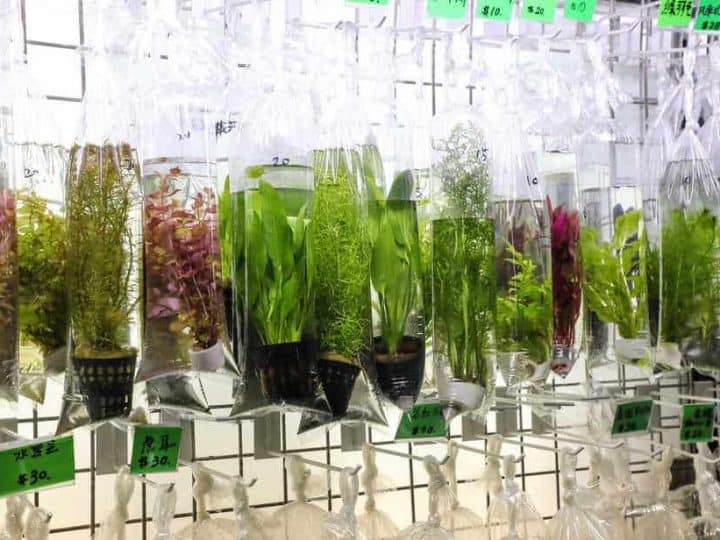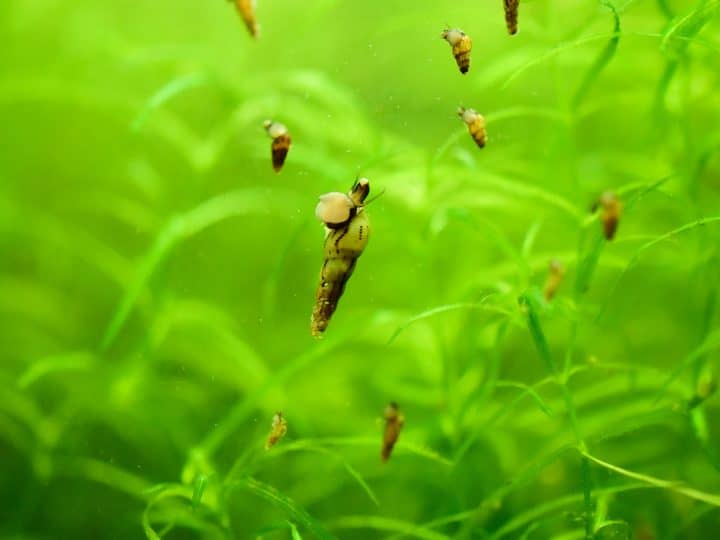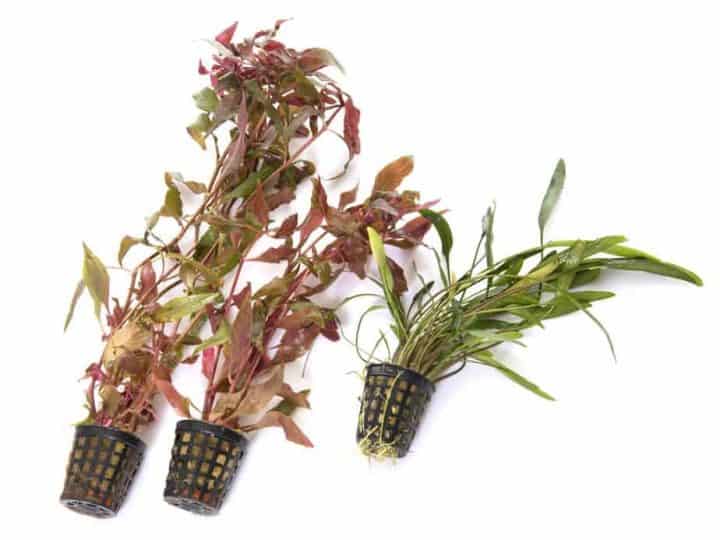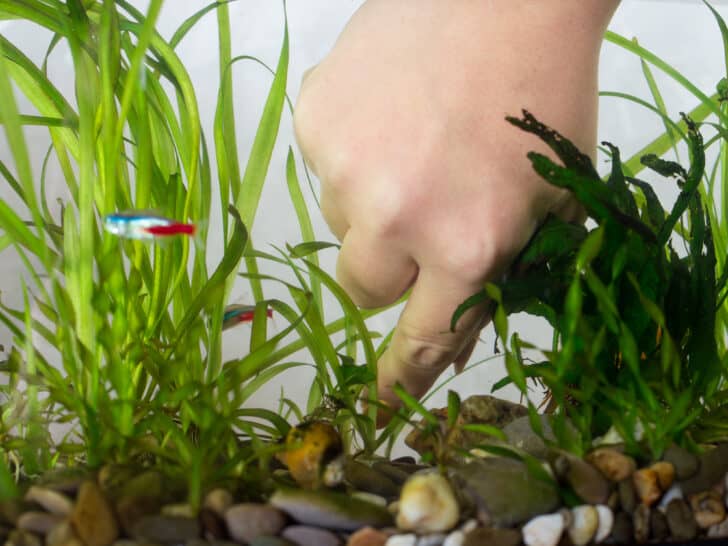One way to quickly sterilize aquarium plants off pests such as fish lice and snails is through bleaching. Hydrogen peroxide is a natural bleaching agent that’s safe to use on nearly every species of ornamental aquarium plant. Bleached plants are perfectly fine for fish, shrimp, and snails, though they may lose some coloration.
Quick Answer
To use hydrogen peroxide dip for aquarium plants, follow these steps:
- Ensure the plants are free from debris.
- Rinse the plants under cool running water.
- Mix the hydrogen peroxide with water.
- Mix the dechlorinator with water.
- Dip the plants.
- Rinse out the bleach and dechlorinate the plants.
- Quarantine the plants.
In this article, I’ll explain these steps in detail. Read on for further information on what to do in each stage, and tips on keeping your aquatic plants healthy.
How To Dip Aquarium Plants Using Hydrogen Peroxide
Below is everything you’ll need, with some items available on Amazon.com:
- Innovating Science Laboratory Grade Hydrogen Peroxide. This product uses laboratory-grade material and can be used as an oxidizer.
- Water. Tap water is fine for this unless your local source has high mineral content.
- Sink or bucket. It should be large enough to fit all of the plants you want to bleach.
- Outset Extra Long Tongs or LOCCEF Gardening Gloves. Since hydrogen peroxide can irritate the skin, you should wear gloves or use tongs when handling plants that have been dipped. The tong is made of stainless steel and has rosewood handles. As for the gloves, they’re reusable, flexible, and eco-friendly.
- Toothbrush. Any toothbrush will do. You can use an old toothbrush for the job.
- Dechlorinator. The API TAP Water Conditioner works instantly, detoxifying water and making it safe for use by plants, fish, and humans.
1. Ensure the Plants Are Free From Debris
Before you begin, make sure the plants are free of debris. If there are any visible algae on the leaves, scrape it off with a toothbrush submerged underwater. It’s also best to remove snails with long tongs or gloves before dipping your plants.
2. Rinse the Plants Under Cool Running Water
After removing snails and debris, rinse the leaves of the plants under cold running water until all soil has been removed from them.
This step is important because if any soil or organic matter is left on the plant leaves, it might become a breeding ground for bacteria after disinfecting the plants.
3. Mix the Hydrogen Peroxide With Water
Once you’ve removed dirt and debris from your plants, mix hydrogen peroxide with water (2 to 3 ml of hydrogen peroxide per gallon of water) in a bucket or sink large enough for all of your plants to fit in without damaging their leaves.
If you have many plants to disinfect, it’s best to use a clean 5-gallon bucket.
4. Mix the Dechlorinator With Water
Next, add a dechlorinator to the water. Most tap water contains chlorine and chloramines that can be harmful to your plants even after disinfecting them.
It’s essential to use a dechlorinator specific for freshwater aquarium conditions. Some dechlorinators will add minerals to your water, which can cause unwanted algae growth.
5. Dip the Plants
Once the hydrogen peroxide solution has been mixed, gently lower your aquatic plants into the bucket.
Ensure not to damage the plant’s leaves while dipping it, or it’ll get nicked and cut when you rinse it out.
Dip the plants in the solution for a maximum of 5 minutes. For sensitive plants, I recommend aiming for a maximum of 2 minutes.
After dipping the plants in the hydrogen peroxide, avoid touching them with your hands while they’re wet.
If you touch a wet plant with your skin, remove the gloves or tongs and clean them thoroughly before handling a different plant.
6. Rinse Out the Bleach and Dechlorinate the Plants
After dipping the plants in the hydrogen peroxide solution, rinse them thoroughly under cool running water until all hydrogen peroxides are removed from the leaves.
Remember that hydrogen peroxide can irritate your skin, so wear gloves or use long tongs to remove the plants from the bucket.
7. Quarantine the Plants
Finally, quarantine all of your plants for at least 14 days before introducing them back into your aquarium.
During this time, monitor the plant leaves for signs of damage and make sure they don’t show any rot or disease before adding them back to your aquarium.
If you see any sign of rot during this period, discard the plant as it can infect other plants.
Here’s an excellent video that explains how to remove algae from aquarium plants using hydrogen peroxide:
Can You Clean Aquarium Plants With Hydrogen Peroxide?
You can clean aquarium plants with hydrogen peroxide. The bleach solution works very well with removing algae and debris from aquatic plants. For the best results, be sure to sterilize the dipped plants in dechlorinated water for 5 minutes before adding them to your aquarium.
Here’s a photo that shows how algae can make your aquarium an eye-sore:
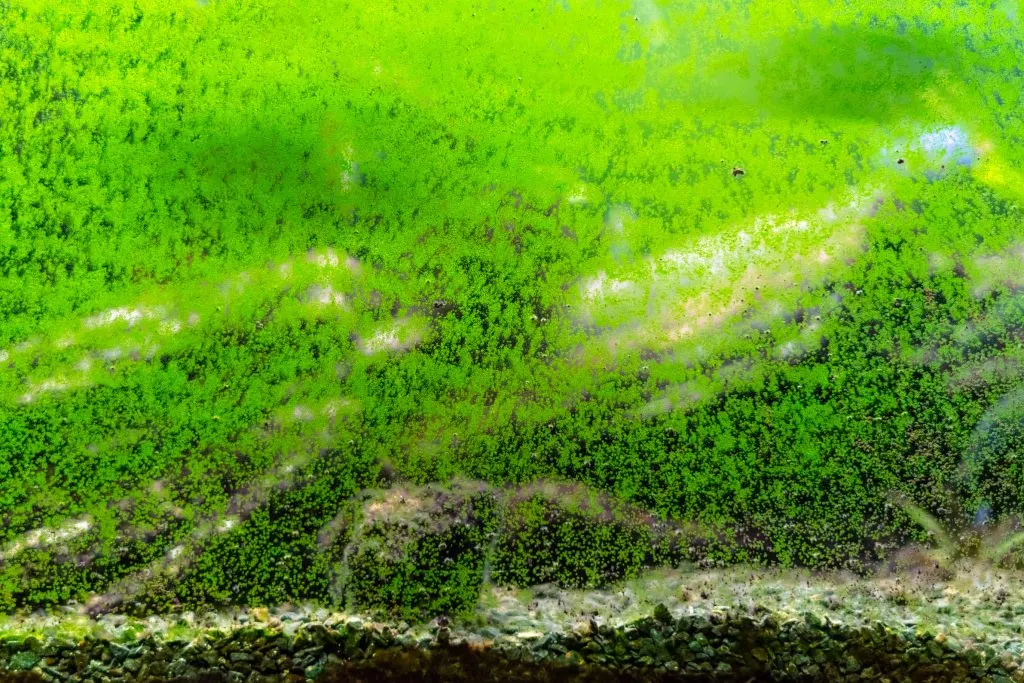
Is Hydrogen Peroxide Safe for All Plants?
Hydrogen peroxide is safe for many plants. Generally, this solution is diluted, making it safe for use. Plants that you can clean with hydrogen peroxide include Java fern, Java moss, Hygrophila polysperma, and the Taiwan shrimp plant.
The benefits of using this chemical to dip plants:
- It can remove algae from plant leaves.
- Hydrogen peroxide reduces the risk of disease by removing bacteria and fungi from the plants’ surface as you rinse them after dipping.
Does Hydrogen Peroxide Get Rid of Algae?
Hydrogen peroxide cleans plants and removes them of algae, fungus, and rot. This solution works very quickly and rinses off easily, so it doesn’t cause any problems for your aquatic plants as long as you use it in mild quantities.
Note that higher concentrations of this compound may burn delicate plants’ leaves, so you should always use the recommended quantities.
Is Hydrogen Peroxide Harmful to Aquarium Fish?
Hydrogen peroxide may be harmful to some fish species, such as walleyes. However, this chemical is generally not harmful to most aquarium fish as long as it’s used in a very diluted solution. In most cases, it’ll only harm any algae or bacteria that are on the plants.
Other Effective Ways To Prevent Algae Growth
Besides dipping your aquarium plants with hydrogen peroxide, you can use several other methods to prevent algae growth on aquatic plants. These include:
Perform Regular Water Changes
Replace about 15 to 25% of the water in your aquarium every 2 weeks. This helps to prevent high concentrations of nitrates and phosphates, which contribute to excessive algae growth.
Remember to remove any decaying matter from your tank before you perform each water change.
Apply Diatomaceous Earth
Most filters will eventually clog with debris if you don’t change the media in them often enough or purchase a cheap filter that doesn’t have replaceable cartridges.
To unclog this debris, most people use diatomaceous earth (DE). DE is a white powder made up of tiny fossilized remains of microscopic one-celled organisms called diatoms. Once dried, DE is a very effective filter medium because it has a porous texture and because the fossils have sharp edges which resemble a cheese grater.
Using a bucket, gently run your filter for 10 to 15 minutes. Rinse the filter material in freshwater to remove any dirt or debris from the fossilized diatoms. You can also do this right in your tank by shaking the filter material into your tank as you would typically rinse it.
Control the Lighting
To prevent algae growth on aquatic plants, always keep your lighting timer set so that all of your plants receive 8 to 12 hours of light per day.
This will ensure they can photosynthesize efficiently and adequately remove excess nitrates and phosphates from the water column.
Use Worm Castings and Beneficial Bacteria
Worm castings (or worm poop) are an excellent source of phosphate-binding bacteria. You can purchase them at any local fish or garden store which sells aquatic plants.
Add a tablespoon to your tank weekly to help control algae growth on the plants. This may help not just by reducing phosphate levels but also by providing additional iron for plant growth.
Keep Algae-Eating Fish
Placing fish that eat algae in your aquarium will quickly reduce algae populations. These fish include koi, goldfish, plecostomus, oto cats, rubber-lipped plecos, Ancistrus catfish, and clown loaches.
It would help to remember that algae-eating fish usually survive much better if you keep them fed with sinking pellet foods and blanched vegetables such as zucchini, cucumber, and peas.
Use Algicides
Algicides are chemicals available at most local fish stores, which kill algae. Their use is unnecessary unless you have problems with algae growth on your plants brought on by overfeeding, dying plants, or decaying organic matter in the tank.
Check the Water’s Nitrite and Phosphate Levels
If you notice any trace of algae on your plants, perform regular water changes, and diligently use DE and worm castings, yet still have problems with algae growth, your last resort is to check the nitrate and phosphate levels in your tank.
If your nitrates and phosphates are still high, do a 10% water change daily until you notice a significant reduction in algae growth on the plants.
You must rely heavily on regular water changes to keep your tank healthy if you have no other methods of controlling algae populations.
Tips on Keeping Your Aquatic Plants Healthy
With enough attention and care, aquatic plants are beautiful additions to a healthy freshwater or saltwater aquarium.
Here are some tips on keeping your aquatic plants healthy:
Mind the Number of Plants in the Aquarium
Don’t overcrowd your aquarium with too many aquatic plants, as this can cause an imbalance in the water chemistry that the fish need to live healthy lives.
Always research how much space you need for each type of plant you want before adding it into your aquarium.
Use Quality Aquarium Plant Soil
Be sure to use quality aquarium plant soil in your substrate. Sandy soils won’t hold nutrients, breaking down quickly and causing an imbalance of nutrient availability in the aquarium water.
Aquatic plant soils are specifically designed for aquatic plants and balance the number of nutrients available to the plant roots so they don’t cause harmful algae blooms or rapid plant growth that can damage other aquarium components.
Monitor the Water Chemistry
It’s essential to monitor water chemistry to ensure there aren’t any drastic changes that could affect your fish’s health.
Always check pH, ammonia, nitrite, and nitrate levels before introducing new aquatic plants into your tank after you have disinfected them or restored your aquarium after any fish dies.
Use Beneficial Bacteria in Your Filter
When adding new plants, rocks, gravels, and anything else from an established aquarium into a new tank, always add beneficial bacteria to your filter media. This will ensure the process goes smoothly without stressing your fish. Stressing out your fish can potentially kill them, and you don’t want that.
Remove Aquatic Plants Gently
When removing aquatic plants from your aquarium, use a pair of tongs like what I’ve mentioned earlier to remove the plants from the substrate. You must do this gently to ensure you don’t damage or uproot your plants. It’s also recommended to wear gloves when doing this.
Be Patient With New Plants
Always give new aquatic plants at least 3 weeks to adjust to their surroundings before judging whether they’re dead or dying.
Aquatic plants have different requirements, and coping with changing water conditions can be difficult until they adapt.
Waiting a few weeks will ensure that your plant is alive and ready to go into the rest of your aquarium.
Mind the Dechlorinator You Use
Some dechlorinators may contain mineral additives that can cause harmful algae growth in your tank.
If you use a dechlorinator, make sure it’s the right type to avoid adding anything that can cause algae growth in your aquarium.
Final Thoughts
Hydrogen peroxide is one of the most effective ways to rid plants of algae, rot, and bacteria. It can be used as a natural alternative to harsh chemicals, like chlorine bleach or antifreeze – which are often toxic when ingested by fish!
This chemical is safe for most aquatic species as long as it’s used in a very diluted solution with water. As always, be sure to follow any safety instructions that come with using this chemical or any dechlorinator you may use.

